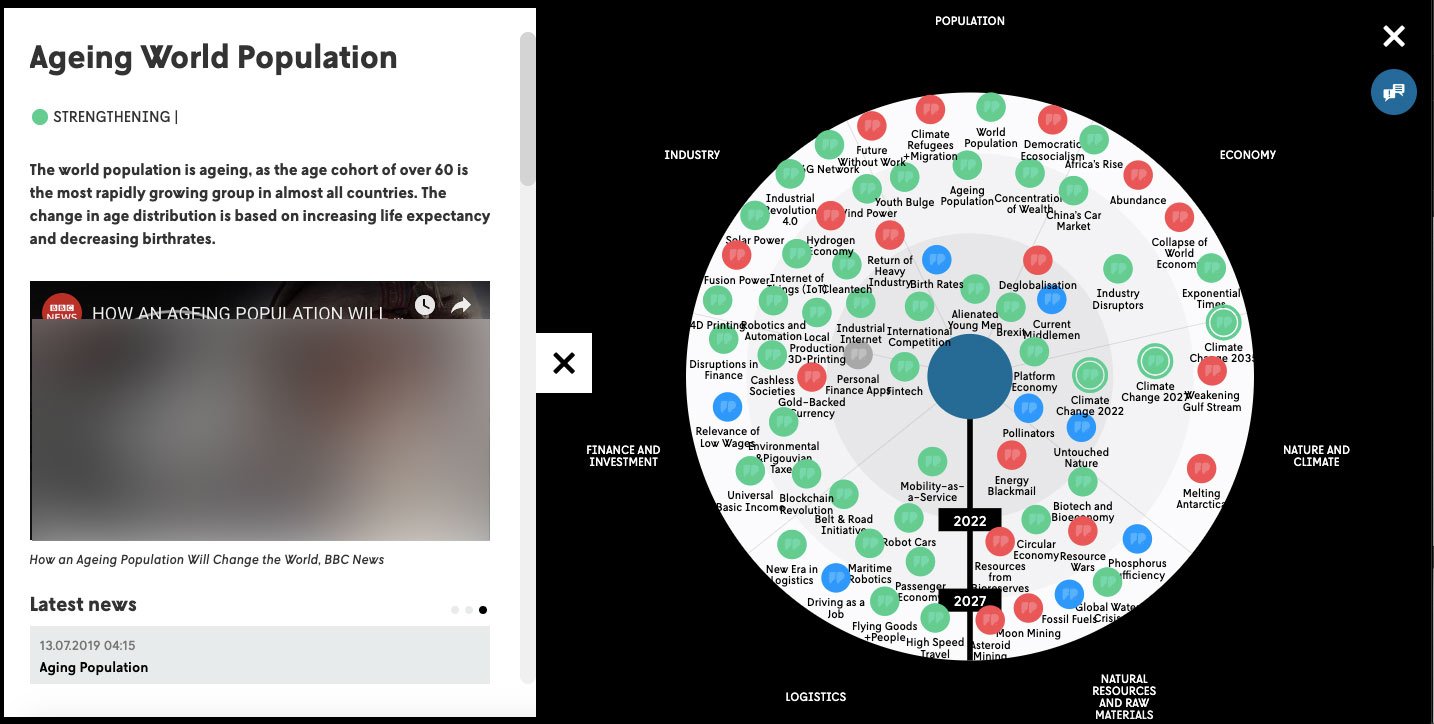Will We Live Longer in the Future?
Can we live for 100 years old? or 150 years old?
FUTURE PROOF-BLOG BY FUTURES PLATFORM
Human life expectancy is on the rise. Whereas the average person born in 1960 could expect to live to 52.5 years of age, someone born today has an average life expectancy between 79 and 83 years of age. The question many of us ask is: how far can we push the boundaries of our human lifespan?
If you are interested to dive into this, and many other future changes, schedule a free demo at Futures Platform and access a database of hundreds of future phenomena curated by leading futurists.
LIFE EXPECTANCY VS LIFESPAN
One key factor for the increase in life expectancy is the decline in child mortality. In 1800, 43% of the world's newborns died before their 5th birthday. In 1960, the child mortality rate was 18.5%, and almost one in every five children died in childhood.
In 2015, that number was 4.3%.
But that’s not the only indicator of the improvement of life expectancy.
A report from Our Wold in Data showed that a 5-year old in 1841 had a life expectancy of 55 years, whereas today, the same child can expect to live 82 years. An increase of 27 years.
The same report also noted that the mortality patterns have changed since the 19th century. A 50-year old lived in England or Wales in 1850 could expect to live another 20 years. Today, the life expectancy of a 50-year old has increased to an additional 33 years.
Medical advances in the last centuries and accessibility to healthcare facilities have helped increase the survival rates in various ages. In 1851, less than half of people born in England or Wales made it past their 50th birthday. Conversely, more than 95% of the population in England and Wales today can expect to live more than 50 years.
Overall, when we are comparing between today and the past 200 years, human life expectancy has increased exponentially because of :
More children survive during childhood and past the age of 5 thanks to vaccination, better nutrition, safer and cleaner living condition, and advanced medical treatments.
People who live past age 5 have more chances of surviving until old ages than their ancestors due to the decrease in health inequality and better public health initiatives.
However, the assumption that human lifespan also increases alongside the increase of overall life expectancy is misleading.
As a BBC article puts it, “Overall life expectancy, which is [a] statistic […], hasn’t increased so much because we are living far longer than we used to as a species. It’s increased because more of us, as individuals, are making it that far.”
The author of the article also credits the safe environment, cleaner and better living conditions of today as more significant contributing factors to longer human lifespan than the advancements of modern medicines. If a man lived in the eras from 1200 to 1745 got to the age of 21 and didn’t die by accident, violence or poison, he could reach an average of anywhere between 62 and 70 years, almost as long as men today.
In fact, humans might have reached our peak of longevity. The figures from the Office for National Statistics show that life expectancy in the UK for 2015-2017 has stopped improving for the first time since 1982.
THE CASE FOR PUSHING THE BOUNDARIES OF HUMAN LIFESPAN
We may not have extended the human lifespan yet, but the good news is, we can.
An article published in Gerontology in 2017 has shown that even though the mortality of centenarians has stayed the same over recent decades, suggesting human longevity stops increasing at a certain age. However, there is no convincing evidence that we have reached the limit of the human life span.
A new study by researchers at Sapienza University and the University of Roma discovers the ‘mortality plateau’ – a point where the risk of death stops increasing as the person grows older. The researchers collect records on every Italian aged 105 years and older between 2009 and 2015 and find that after the 105th birthday, the odds of someone dying from one birthday to the next are roughly 50:50.
If the future of human longevity is not predetermined, it will depend on human efforts to extend our lifespan.
Despite some exceptions, the world has annually gotten safer since the Middle Ages. Even though the news might suggest otherwise, homicide rates and deaths caused by conflicts, childbirth, accidents, and famine have been steadily decreasing for a long time.
A recent study published in the Proceedings of the National Academy of Sciences, by Stanford University biologist Shripad Tuljapurkar found that the average age of death in those who live to be older than 65 increased by three years in every 25-year period. It means that people can expect to live about six years longer than their grandparents, on average.
The same research suggests that our efforts in attempting to increase human lifespan are not in vain. Previous researched pegged the human lifespan at around 115 years of age, but that data has been contested (and subsequently defended). We have also since seen a few people living longer.
WHAT DOES THIS PHENOMENON MEAN TO OUR FUTURE?
In a future where everyone can live 115 years or over, we can expect a couple of social-economic changes to accommodate more senior citizens:
1. Older Retirement Age
Thanks to increased life expectancy and advanced medical care, people will have more years of healthy life than ever before.
And when people start living longer, they are going to keep working.
More and more pensioners continue studies, launch new businesses, act as work-life mentors, become authors, or turn active as regards societal issues. According to the US Bureau of Labor Statistics, workers aged 55 or older will become the largest share of the labour force.
All credits belong to the US Department of Labor
Older workers have excellent work ethics, too. Research from the Milken Institute’s Center for the Future of Aging and the Stanford Center on Longevity found that older employees took fewer sick days, showed stronger problem-solving skills, and were more likely to be highly satisfied at work than younger colleagues.
As a result, society has to cater to the needs of the new and active pensioners, and their wide variety of lifestyles needs to be taken into consideration in decision-making.
2. New Types of Retirement Plans
An increase in life expectancy and the decline in fertility rates have put enormous pressures on traditional employment-based and state pensions. A study by the World Economic Forum examined life expectancy and saving provisions across major world economies and found that people should expect to outlive their retirement savings by between eight and 20 years on average, with the highest-burden on women.
It is essential to develop new retirement plans to close the savings gap.
Many countries have started considering hybrid solutions combining state pension, private pension schemes, private savings and pensions accounts as well as an option to decrease pension amounts during economic contractions.
One example of these “hybrid pension scheme” is the Central Provident Fund (CPF) in Singapore. It is based on a monthly investment by both employers and employees, at roughly 20% of the size of the employee’s monthly salary. This investment is paid to the individual’s own pension account. The funds in these accounts are used to make investments, mostly to Singapore’s own property market. CPF is a hybrid model combining a savings fund, real estate investing and public social insurance.
To qualify for the CPF, all members are requested to set aside a Minimum Sum of $155,000 (in 2015) in the Retirement Account upon reaching the age of 55. Only Singapore’s citizens and those who have permanent resident status are entitled to the CPF contribution.
3. Prioritize Care and Increase Deductible
With more and more people approaching older ages, the public health system is facing an upward challenge of dealing with the extra amounts of patients with limited funding.
Some countries offering public healthcare have to prioritize and ration publicly funded healthcare services. The drawback of health care prioritization is that patients sometimes have to wait for weeks, or even months to meet their doctors.
That’s why some people are now turning back to private healthcare to ensure their needs are met in time. Another alternative is to increase the patients’ deductible, i.e. the price the patients have to pay for themselves.
This often helps cover part of the costs associated with the services. The problem, however, is that rising personal costs are particularly burdensome for the underprivileged.
CONCLUSION
We might not have found the Foutain of Youth, but with a better lifestyle, safer environment, and the support of medical advances, humans can push the boundaries of the human lifespan to live longer than ever before.
Governments and employers have to re-think new policies and approaches to cater to the need of a new, older labour force; as well as help the future retirees relax and enjoy their golden years.
This article takes inspiration from the work of Futures Platform team “Change in Population, Demographics, Generations, Displacement and Refugees 2022“. Futures Platform examines hundreds of future trends across several fields and put them into 360-degree trend radars. A trend radar helps you visualize the connections among future trends and design your future.
Futures Platform is the industry standard online solution to support continuous foresight, strategy development, risk management, and analysing groundbreaking innovations. Schedule a free demo to learn more






